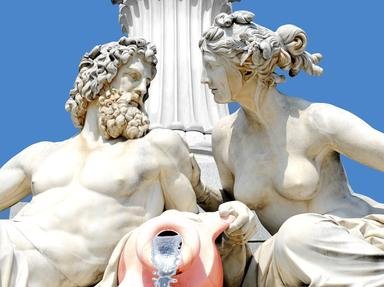Quiz Answer Key and Fun Facts
1. On the Rhine River there stands a rock that causes a booming echo for river travelers. Legend says that the echo is the voice of a beautiful woman who drowned in the river near the rock. She was turned into a siren and now waits there, combing her golden hair, luring men with her voice. Both she and the rock have a name that means "luring rock." What spellbinding songstress is this?
2. Another mournful lass whose life ended in a river, this young nymph could make rocks move and beasts halt with her enchanting voice. She was the daughter of Janus and was to marry the king Picus. Alas, as so often happens, he was turned into a woodpecker just before the wedding. Grieving at her love's fate, she laid herself in the Tiber to drown. Her name is from the Latin for "to sing." What Roman mythological heroine is this?
3. Here's an easy one - if you're free from misconceptions. The kinnara of Buddhist myth are human-animal hybrids who live in the mountains and come down to delight humans with their songs. They're represented as half-animal, half-human hybrids - the same animal, in fact, as the earliest depictions of Greek sirens. What animal is a kinnara's lower half?
4. The voices of banshees are enchanted for a very different reason. They're horrible, ear-piercing screams that can break glass; they echo the funeral "keening" of the Ireland of yore. It is said that hearing a banshee reveals that someone in your family has died or will soon die. If a loved one died overseas, the banshees would know before the post could get there. Derived from the Irish words "bean sídhe," the name "banshee" indicates the place you're most likely to find them. Where?
5. In Slavic folklore, we find yet another group of sylphs with potent songs. Representing the wayward spirits of the drowned and the unbaptized, rusalki also enchant seafarers with their beautiful voices. A rusalka won't just steer you towards the rocks, though. They have a decidedly hands-on way to dispatching you. What is it?
6. In medieval Europe, this plant was prized, with properties ranging from magical to medicinal to psychotropic. Getting it out of the ground was another story. Supposedly, when it's removed from the ground, it will emit a shriek so loud it will kill anyone who hears it. A famous fictional wizard once had to repot one to pass Herbology. What plant is it?
7. Huehuecoyotl was a shapeshifting trickster god of the Aztec peoples - specifically revered by the Otomi, an indigenous people who survived the conquistadors. His name means "Old Coyote," and like those howling jackals of the Indies, Huehuecóyotl was known for his music - his singing, flute-playing, and drumming. Besides his age and his enchanting music, he was also associated with lighting fire and corn. What did these symbolize to the Aztecs?
8. Perhaps the most powerful musician in Greek and Roman mythology was Orpheus, the son of a Muse and a king. A member of the Argonauts, he protected the crew from sirens with his own counter-enchantment. But his most famous song was sung to win appeal a certain god to help in rescuing his beloved Eurydice. What god did Orpheus' music charm?
9. This real-life 6th century Chief of the Bards had passed from history to folk legends by the 11th. A Welshman, perhaps from the historical Kingdom of Powys, his mother, according to legend, was the white witch, Ceridwen. In addition to being a great poet, he used his singing to free his foster father, Elfin, and served King Arthur alongside Merlin. Frank Lloyd Wright had two studios named after this figure. Who was he?
10. Väinämöinen, the "Everlasting Singer," is a magician in Finnish folklore. A traveling shaman, he used his voice to enchant many of his enemies, in one story singing a lullaby to sneak past a hall of warriors. He also invented Finland's national instrument from a fishbone. What is the name of the national epic in which many of Väinämöinen's exploits are recorded?
Source: Author
etymonlego
This quiz was reviewed by FunTrivia editor
looney_tunes before going online.
Any errors found in FunTrivia content are routinely corrected through our feedback system.
